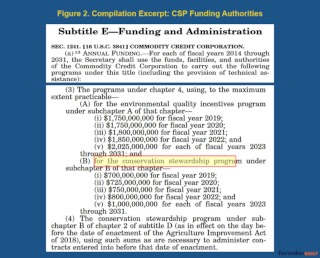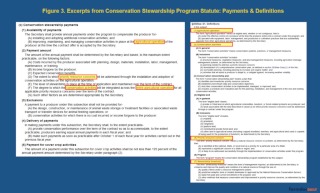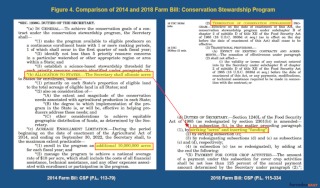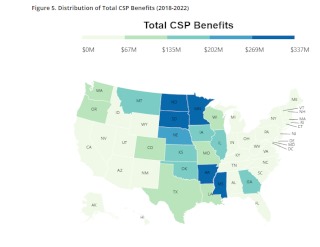Background
The articles in this series explore the major mandatory titles, policies, and programs in the Farm Bill, as well as updates on the Policy Design Lab project (farmdoc daily, April 13, 2023). A work-in-progress, the Policy Design Lab provides a web-based resource in which to explore and analyze existing policies and policy alternatives. It works from statutory and legislative text to incorporate and apply research, publicly available data, and computational resources for analysis and visualization. The research and data are guided by statutory text to produce comparative analysis. One goal will be to advance understanding about existing policy outcomes, as well as research-backed potential outcomes of alternative designs. Eventually, it will also seek to improve understanding of the policymaking process and facilitate open discussions about policy options. Development begins with the major mandatory farm bill programs to establish the status quo, visualized through maps and charts of the distribution of benefits and payments by State. This installment explores the policies and spending of the Conservation Stewardship Program (CSP).
Discussion
In the Agricultural Improvement Act of 2018 (P.L. 115-334), Congress reauthorized CSP through FY2023 and extended the authorization through FY2031 in the Inflation Reduction Act of 2022 (P.L. 117-169). The statutory text for all Farm Bill authorizations can be found on the compilations page of the Senate Committee on Agriculture, Nutrition, and Forestry (Senate ANF) website (Senate ANF, Library: Compilations). The Office of the Law Revision Counsel of the U.S. House of Representatives maintains the up-to-date U.S. Code and CSP is in Title 16, Chapter 58 (16 U.S.C. §3839aa-21 et seq.). Figure 1 presents an excerpt of the establishment and purpose of the CSP program as currently authorized.

CSP is also funded through the Commodity Credit Corporation (CCC), which provides mandatory funding each fiscal year using borrowing authority. In the 2018 Farm Bill, Congress authorized fixed amounts of funding each fiscal year for EQIP, beginning with $700 million in FY2019, increasing to $1 billion in FY2023. With the Inflation Reduction Act, that funding authorization of $1 billion continues through FY2031. Figure 2 is the funding authority from the Senate ANF compilation.

CSP is also funded through the Commodity Credit Corporation (CCC), which provides mandatory funding each fiscal year using borrowing authority. In the 2018 Farm Bill, Congress authorized fixed amounts of funding each fiscal year for EQIP, beginning with $700 million in FY2019, increasing to $1 billion in FY2023. With the Inflation Reduction Act, that funding authorization of $1 billion continues through FY2031. Figure 2 is the funding authority from the Senate ANF compilation.

The authorized CCC funding and the appropriated additional Inflation Reduction Act funding are both used to offer to farmers the ability to apply for five-year contracts and, if accepted, they will receive an annual payment in an amount determined by USDA in accordance with the statute. To be accepted, a farmer must demonstrate that the farm operation meets or exceeds a stewardship threshold for at least 2 priority resource concerns and would minimally meet or exceed the stewardship threshold for an additional priority resource concern by the end of the contract term. Figure 3 provides excerpts from the statute for these key terms and provisions.

CSP offers a valuable case study of policy design because Congress revised the program significantly in the 2018 Farm Bill. Among those revisions, CSP no longer operates on an acreage basis; prior to the changes in 2018, USDA was required to increase enrollment by 10 million acres each fiscal year. In 2018, Congress placed the program on specified funding authorizations and combined the authorities with EQIP. Figure 4 compares excerpts from the 2014 Farm Bill version (P.L. 113-79) and the 2018 Farm Bill version (P.L. 115-334) of CSP, highlighting revisions and the repeal of the 2014 version of CSP.

Finally, Figure 5 is the interactive map of the total CSP payments from FY2018 to FY2022 by State and the State’s share of the national total (https://policydesignlab.ncsa.illinois.edu/csp). CSP provides assistance through annual payments to the farmer pursuant to a five-year contract and contracts can be renewed. As such, the total funding includes payments under both the 2014 Farm Bill and 2018 Farm Bill versions. To visualize this, the map presents the 2014 Farm Bill version of payments using categories based on the types of eligible land; the 2018 Farm Bill version of payments uses the same categories of practices as the EQIP program. In total, the map presents the distribution of $3.9 billion in payments distributed across the 50 States. For close observers, that total is less than the total obligations of nearly $2.9 billion reported by NRCS on its website (https://www.farmers.gov/data/financial-assistance/overview). The map is based on data received by NRCS through a Freedom of Information Act (FOIA) request for payments by fiscal year, practice, and State. NRCS reports obligations by contract, which may account for some of the discrepancy, but further review will be undertaken.

In terms of performance by state, South Dakota has received the most in total payments at nearly $337 million from 2018 to 2022 (8.6% of the national total), followed by Minnesota at $297 million (7.6%) and Arkansas at $293 million (7.5%). Comparing the 2018 version of the program to 2014, just over 78% of the total benefits are attributed to the 2014 categories using eligible land provisions. CSP uses five-year contracts and the last year for a contract entered into under the 2014 provisions would have been FY2018. Farmers also have the option to renew their contracts, all of which helps explain the large share of total spending attributed to the 2014 version of the program.
The map and chart features permit a user to select the totals attributed to the 2014 and 2018 versions of CSP, which also provide useful comparisons. Under the 2014 version, South Dakota remains the top recipient of CSP benefits from 2018 to 2022 with $273 million (8.9%), followed by Minnesota at $243 million (7.9%) and North Dakota at $226 million (7.3%). Under the 2018 version with payments attributed based on practices similar to EQIP, Mississippi is the top recipient of payments at nearly $130 million (15% of the national total), followed by Arkansas at $85 million (9.9%) and South Dakota $63.5 million (7.4%). This initial review of state performance raises questions about whether the revised version of CSP in the 2018 Farm Bill has altered the distribution of payments and benefits among states and farmers.
Concluding Thoughts
The words of the statute put policies into action, including the distribution of benefits. A Policy Design Lab being developed at the University of Illinois is working to apply research, data, computational resources, and statutory or legislative textual analysis to visualize policy design. This article reviewed the Conservation Stewardship Program, highlighting the distribution of payments or benefits. It also provided an initial study of policy design by comparing distributions according to the design of the 2014 version of the program and that of the 2018 version. In the 2018 Farm Bill, Congress made significant revisions to CSP that began with ending the requirement to increase the program by 10 million acres each year. The 2018 version operates under a fixed amount of funds each fiscal year, but also incorporates conservation practices in a manner similar to the Environmental Quality Incentives Program. An initial review of the changes in program design indicates a corresponding change in the distribution of benefits among states and farmers. Further exploration and analysis of the program design will be undertaken to help clarify the impact of the design revisions on the program’s operation and the distribution of assistance.
Source : illinois.edu